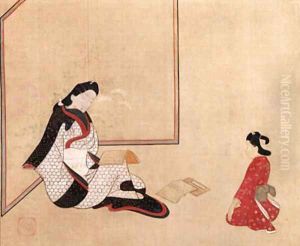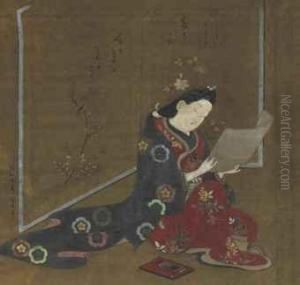Hishikawa Morofusa Paintings
Hishikawa Morofusa was an artist whose specific birth and death years are not well-documented in the historical record. This lack of information is not uncommon for many artists, especially those who lived and worked in earlier centuries or in periods where record-keeping and historical documentation were not as robust as they might be in more contemporary contexts. Despite the scarcity of personal details about Morofusa's life, it is possible to contextualize his work within the broader scope of Japanese art history, particularly within the Edo period (1603–1868), a time characterized by strict social orders, economic growth, and a flourishing of arts and culture under the rule of the Tokugawa shogunate.
Morofusa is often associated with the ukiyo-e genre, a style of Japanese art that flourished from the 17th through the 19th centuries. Ukiyo-e, which translates to 'pictures of the floating world,' is known for its focus on the transient pleasures and beauty of the mundane world. Artists in this genre produced woodblock prints and paintings that depicted a wide range of subjects, from scenes of daily life and landscapes to narratives from folklore and the kabuki theater. While Morofusa's place within the ukiyo-e tradition suggests that he contributed to these rich artistic narratives, the specific themes and subjects of his works are less well-known than those of his contemporaries, such as Hishikawa Moronobu, a prominent figure in the development of ukiyo-e.
Without specific works definitively attributed to him, understanding Morofusa's artistic contributions requires a broader appreciation of the ukiyo-e genre and the cultural and historical contexts in which it evolved. The period was marked by a burgeoning urban culture in cities like Edo (modern Tokyo), Osaka, and Kyoto, where a merchant class was emerging as a significant patron of the arts. This socio-economic backdrop allowed for the proliferation of art that was accessible to a broader audience, a shift from the previously dominant aristocratic and religious patronage.
In summary, while the exact details of Hishikawa Morofusa's life and oeuvre remain elusive, his association with the ukiyo-e tradition places him within an important chapter of Japanese art history. His work, and that of his peers, reflects a period of significant cultural and artistic development in Japan, offering insights into the social dynamics, aesthetic preferences, and everyday life of the Edo period.

